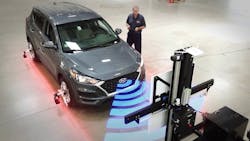Millimeters matter in ADAS calibrations
Key Highlights
- Proper vehicle alignment is essential before calibrating ADAS to ensure sensor accuracy and prevent safety issues.
- Manual measurement tools are prone to human error; automated calibration systems improve precision and save time.
- Following OEM-specific procedures, including static and dynamic calibration methods, is crucial for accurate ADAS recalibration.
- Advanced calibration tools with real-time OEM data access streamline the process and reduce the risk of mistakes.
- Using high-tech equipment ensures faster, more reliable ADAS calibration, maintaining vehicle safety and customer trust.
Drivers rely on their vehicle’s Advanced Driver Assistant Systems (ADAS) for a growing number of safety features – from adjusting headlights to automatic parking and advance braking to monitoring blind spots. New vehicles equipped with ADAS make driving easier and safer, and drivers expect the ADAS systems in their vehicles to be accurate, whether the vehicle is fresh off the new car lot or has been repaired after a fender bender or major accident.
The repercussions if that system is even off just slightly can be deadly. For example, drivers rely on ADAS to assist in braking when a car stops quickly in front of them or when a pedestrian or animal darts into traffic. ADAS also helps keep drowsy drivers awake and distracted drivers in their lane. It is essential in these scenarios that the ADAS system performs properly and accurately.
Beyond the important safety issue, a bad ADAS calibration can also just be plain annoying for a driver. Imagine a constant alert from the blind spot or proximity monitor when there is nothing there, a warning light or message on the instrument panel they can’t resolve, or a constant steering wheel vibration or pull. It is enough to drive a driver crazy and could certainly lead to frustration, bad word of mouth for the repair business, and perhaps even a lawsuit.
This means one of the most critical parts of the repair process for any vehicle is ensuring an accurate recalibration of the ADAS system. Bad calibrations are never intentional, but when millimeters matter, mistakes can happen. And when you know how they happen, they can be avoided.
Calibration Mistake #1: Not Ensuring Proper Alignment
Before technicians can even start to look at calibrating a vehicle’s ADAS system, the alignment needs to be checked and, most likely, corrected. Whether the vehicle is in the shop for repair after an accident or a run-in with a pothole or curb, the alignment has likely taken a hit. Ensuring the alignment is back in line is a crucial step that cannot be skipped. It must be done prior to ADAS calibration.
That’s because many ADAS features work hand-in-hand with the vehicle’s alignment and steering components, and when one is out of whack, the other is bound to cause problems. Suppose that the steering angle sensor is a bit off. The forward-facing camera might incorrectly think the steering wheel is turned and start signaling the vehicle to correct the steering even though the driver is keeping the car between the lanes. This could cause driver confusion, annoyance, or even an accident.
Trained technicians know how to precisely align a vehicle and get the suspension back into proper form. But even once the vehicle is aligned properly, the tech needs to make sure several other steps have been followed perfectly in order to get an accurate calibration. Does the vehicle have a full tank of gas? Are the tires the right size and inflated to the specific pressure required? Is the windshield clean? What about the ride height and steering angle? There are a lot of boxes to check and missing even one can lead to an inaccurate calibration.
Calibration Mistake #2: Manual Measuring
Another culprit when it comes to inaccurate ADAS calibrations is the use of manual measurement tools. We’re talking tape measures, plumb bobs, and technicians who are human and, as the saying goes, are known to err. For any of these tools or even the operator of these tools, being off by even a fraction of an inch can throw the entire calibration off.
Even just parking the vehicle in the right spot to run a calibration assessment can feel like a nearly impossible task. It can take hours and involve a lot of trial and error. Non-automated systems might have a tech lay a string on the ground, use plumb bobs from the center emblem on the hood, stretch out a tape measure or physically adjust the target stand to line everything up just right. There is a lot of room for error in that scenario – particularly of the human variety. So much of this initial and crucial step requires technicians to use their best judgement and personal interpretations of the measurements, which will vary from person to person. That means it’s very unlikely that two of the exact same vehicles would be set up in the same manner – even within the same repair shop.
Add in the tiny size and large number of sensors and it’s a recipe for trouble if you are relying on old-fashioned tools and human judgement. Most vehicles now have small sensors built into windshields, mirrors, behind bumpers, and more. Repairing sensors that are so tiny you can’t really see or get your hands on can be frustratingly difficult. Relying on a tape measure, string, a metal weight, and a person’s best interpretation of a measurement sure seems a little outdated next to the high-frequency radars, high-definition cameras, ultrasonic transmitters, and sensors you’re trying to calibrate.
Calibration Mistake #3: Not Following OEM Procedures
Collision repair companies are well-versed in OEM procedures and requirements – they’ve always needed precise specs to make a vehicle look and run like new. But with ADAS calibration, tracking down and following the OEM standards can be another difficult step in an already challenging repair.
That is because OEMs often slightly modify safety features on a vehicle model from one year to the next. Technicians must manually track down the exact OEM repair procedure and follow it step-by-step. That entails finding the exact make and model number of the vehicle, following a clear, reliable process that can be repeated again and again without mistake, and using the specific ADAS calibration tools recommended by the OEM to complete the repair.
OEMs also vary in whether they want recalibrations done using static or dynamic calibration. Dynamic calibrations are done while the vehicle is in motion. Static calibrations are done with the vehicle in one static location, using targets to correct any errors. Some OEMs even require a mix of the two, which is why tracking down the OEM's specifications is so important.
Equally important in following OEM procedures is record-keeping. Shops need to keep detailed records of their repair process, including who did the repairs, when, where, and how were they done, what process and tools were used, which repairs were not completed, and what sort of training the technician had prior to completing the repair. If this sounds like a lot to keep straight, it is, and it creates too many opportunities for potential missteps.
How to Ensure Accuracy
Thankfully, new technology can help ensure the accuracy of the ADAS calibration process using lasers, levels, and electronics to get the job done.
An automated calibration system makes the measurement and alignment process much easier, faster, and more accurate. With these systems, the tech can park the car within 4-5 inches of the target and then attach wheel clamps so the machine can read the distance to the target. The system then automatically adjusts all other measurements – distance, height, width, and yaw – in just a few minutes. The entire measurement and alignment process can be done in far less than the hours it used to take, and the calibration can begin.
The most accurate specs from the OEM can be found quickly and easily with new ADAS calibration tools as well. Some systems like Chief Collision Technologies’ Mosaic ADT, powered by Burke Porter Group, have a direct connection to OEM data and can access real-time updates to the vehicle repair requirements as they become available. The software allows techs to enter a VIN number into the machine. Then the software pulls up the exact process needed for an accurate repair and guides the technicians through every step.
The need for pinpoint accuracy when it comes to ADAS calibration can be intimidating at first glance. After all, there are tremendous risks if it is not done right. But that is why it is important to use the right tools for the job. Fight fire with fire if you will. Don’t rely on old-fashioned tools to repair an incredibly high-tech system. Instead, use technology to your advantage in repairing and recalibrating the tech on the vehicle. Using the right, high-tech system will make the calibration job faster, easier, and far more accurate – allowing you to send your customers back onto the streets with the same confidence they had in their vehicle’s safety systems as the first day they drove the car off the lot.
About the Author
Mike Croker
Mike Croker is the director of product management at Chief Collision Technology. He is a devoted advisor for various technical school organizations and a national technical committee member with SkillsUSA. Mike uses a hands-on approach in training to serve as an I-CAR instructor and is an ASE subject matter expert for Structural Analysis and Damage Repair. For more information, visit www.chieftechnology.com or email him at [email protected].

